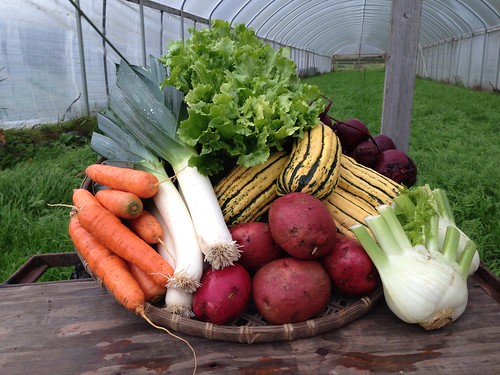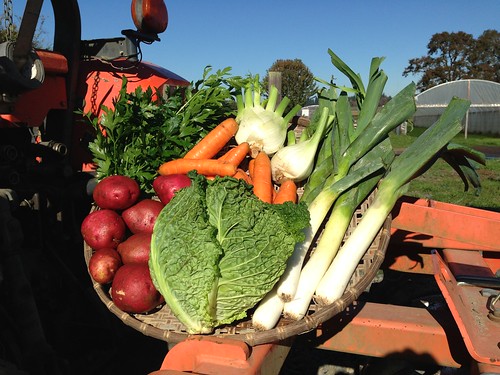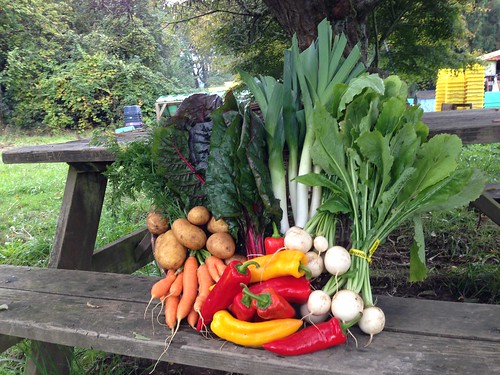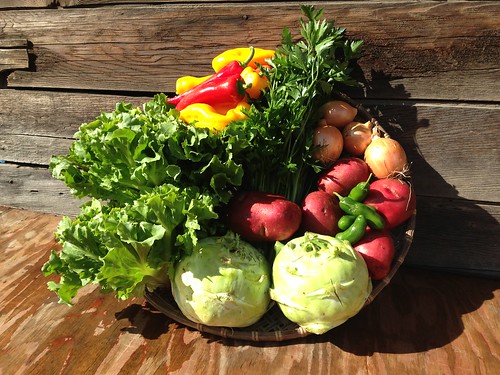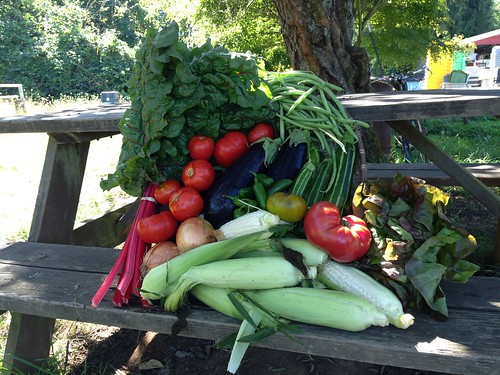Some new and old favorites–two fairly quick one-pot dinners that are ideal CSA catch-alls. My favorite fall winter condiment in the form of a reduced apple cider syrup that is the perfect ingredient for an escarole salad. . . Happy cooking!
One-pot Winter Squash and Pasta with Escarole
Escarole Salad Note
Apple Cider Syrup
Wilted Escarole (with Roasted Beets?)
Pureed Beets with Yogurt and Za’atar
Maple Spice and Delicata Bowl
CSA Risotto with Leek, Fennel, Carrots
Seafood and Fennel Soup (link)
One-pot Winter Squash (and Fennel?) and Pasta with Escarole
I created this recipe for a cooking workshop with Early Head Start staff last week. The escarole is a SIO addition but this has already become a favorite in our household—fast, one pot, endlessly adaptable! It makes good leftovers and can be adapted with spices, herbs and other vegetables or meats even depending on your taste and/or what you have on hand. You can change the ratio of vegetable to pasta and if you add the fennel (as suggested below) you could reduce the pasta by ½ cup and reduce the liquid by a bit as well.
I think dicing a fennel bulb and adding it to the onion or leek would be a delicious addition.
Generously serves 4-5
Oil
1 onion, diced (or 1 large leek, well washed, halved and thinly sliced)
1 fennel bulb, trimmed and cut into small dice (optional)
1 small-ish delicata squash, scrubbed but not peeled, halved, seeds and strings removed and cut into small chunks
1 teaspoon fresh or dried thyme
1 ½ cups small pasta such as small elbow macaroni or ditalini (tiny tubes)
3 ½ cups water (or broth or chicken stock)
3-4 cups shredded escarole
Salt
½ cup or so grated cheese (parmesan or sharp cheddar or whatever grate-able cheese you have)
Black pepper
In a large heavy skillet heat about 1 tablespoon oil over medium high heat. Add the onion and thyme, if using, and cook for about 5 minutes until the onion softens. Add the squash pieces and a few pinches of salt and cook for about 5 more minutes, stirring often. Add a little oil if it starts sticking. Add the pasta and the water and about ½ teaspoon of salt. Stir well, bring to a boil and then turn down to a simmer. Cover and cook for about 8 minutes. Check occasionally to see if there is enough liquid. When the pasta and the vegetables are almost tender add the escarole and cook for 2 more minutes. Most of the liquid should be absorbed at this point. Take it off the heat and stir in the cheese and add some black pepper. Taste and adjust seasoning with salt if need be. Cook for another few minutes if at all watery. You want to have a silky sauce coating the pasta.
Escarole Salad Note
I love heartier and more strongly flavored greens for salads and escarole is a favorite. It stands up beautifully to Caesar-like dressings or capers and hardboiled eggs. I also like it with a dressing that includes a teaspoon or so of apple cider syrup (recipe below), sherry or red wine vinegar, olive oil s & p and some shaved manchego and toasted filberts. Heaven!
Wilted Escarole (with Roasted Beets?)
–from Chez Panisse Vegetables by Alice Waters
Escarole is part of the fall/winter greens in the chicory and endive families. I love them all—they are crunchy and slightly bitter (in a very pleasing way when dressed or cooked) and can often be cooked or grilled since they’re more substantial than other lettuces.
This is a very simple technique that just begs for a fried or poached egg or maybe some fish or lovely bowl of beans and good olive oil as an accompaniment.
Wash and trim the escarole. Cut the leaves into wide strips. Saute in olive oil, covered, until wilted and bright green, about 2-3 minutes. Season with salt and pepper, add a splash of vinegar, and serve.
While I haven’t tried them together I would imagine some roasted beets dressed with red wine or sherry vinegar on the side, would be lovely.
Apple Cider Syrup
This is my go-to secret ingredient in salad dressings, soup and dessert enhancers from now until late spring!
Bring 1 gallon of cider to a boil in a large pot. Uncover the cider and cook on high heat until the cider has reduced to about to about 3 cups. You’ll want to check it periodically to see if it’s getting syrupy and viscous. It will depend on your pan and your stove as to how long this takes. My guess is somewhere around – 2 hours but start checking after about 90 minutes. If you cook it too long you get a wonderful apple cider caramel if you stir in a bit of cream and a tablespoon or so of butter.
When the syrup is cool pour into glass jars and keep in the refrigerator or freezer (for back up). Use a couple of teaspoons in salad dressing or drizzle over Greek yogurt, or on your hot cereal, or in salad of thinly sliced fennel, etc.
Pureed Beets with Yogurt and Za’atar
–from Jerusalem by Yotam Ottolenghi and Sam Tamimi
This is a gorgeous, easy to make and elegant dish. I just eat it by the spoonful and spoon it into warm pita bread. It makes quite a bit so halve the recipe if you’d like but go ahead and roast all 6 beets while you’re at it and use half for something else.
6 medium beets (1 1/2 pounds), trimmed and scrubbed
2 small garlic cloves, minced
1 small red chile, seeded and minced
1 cup plain whole-milk Greek yogurt
3 tablespoons extra-virgin olive oil
1 1/2 tablespoons pure maple syrup
1 tablespoon za’atar (middle-eastern spice mix including hyssop and sesame seeds—I found it at People’s co-op recently). You can substitute a mixture of dried thyme and toasted sesame seeds.
Salt
1/4 cup roasted skinned hazelnuts, chopped
2 tablespoons goat cheese, crumbled
2 scallions, thinly sliced
Preheat the oven to 350°. Put the beets in a small roasting pan and add 1/4 cup of water. Cover with foil and bake for about 1 hour, until tender. Let cool slightly.
Peel the beets, cut into wedges and transfer to a food processor. Add the garlic, chile and yogurt and pulse until blended. Add the olive oil, maple syrup and za’atar and puree. Season with salt. Scrape into a wide, shallow bowl. Scatter the hazelnuts, goat cheese and scallions on top and serve with bread.
Maple Spice and Delicata Bowl
–adapted from The Sprouted Kitchen
This recipe is written to include kale which you don’t have in your share this week. You can just omit the kale, or substitute wilted escarole (for a slightly moister texture than the baked kale) or toss the squash and fennel with a bunch of fresh parsley or cilantro.
A note on texture. As written, the kale ends up somewhere between a kale chip and sauteed kale – crisp edges and a tender center. If you want it more crisp, make sure your kale is completely dry and add 5 minutes to the baking time. If you prefer it less crisp, take 5 minutes off the baking time, giving it just enough time to wilt.
2 small delicata squash (about 1 – 1.5 lb. total) skin on, halved and seeded
1 large fennel bulb
2 tablespoons olive oil, divided
1 tablespoon maple syrup
1 teaspoon whole grain mustard
1/4 teaspoon red pepper flakes (or less if you don’t like much spice)
1/2 teaspoon cinnamon
1/4 teaspoon fresh grated nutmeg
salt and pepper
1 bunch kale, stems removed (see headnote) or escarole
3 tablespoons minced red onion
Preheat the oven to 400′. Arrange one oven rack in the upper third and one on the bottom third.
Slice the squash into 1” half moons. Slice the fennel down the center, cut out the tough core, slice into 1/2” wedges. Spread everything on a rimmed baking sheet. Drizzle with 1 tablespoon of the olive oil, maple, mustard, cayenne, red pepper, cinnamon, nutmeg and a few generous pinches of salt and pepper. Toss gently to coat everything, adding another drizzle of oil or maple if it seems too dry. Roast in the oven for 35-40 minutes or until the squash is tender and caramelized, tossing the vegetables half way through.
Rip the kale into large chunks, drizzle it with remaining olive oil and a pinch of salt and pepper. Spread it on another baking sheet. At the 30 minute mark, move the squash tray to the lower rack and put the kale on the top rack. Bake for 10 minutes until the edges are crisp. Add your minced onion and gently toss everything together. Enjoy warm.
CSA Risotto with Leek, Fennel, Carrots
Tonight I had 1 yellow sweet pepper, 1 bulb of fennel, 1 red onion and a bunch of broccoli about to go bad and 1 bunch of red chard stems. So I made risotto with all of it and not very much rice in fact. It was just dandy and I feel very pleased about my cleaned out crisper ready for tomorrow’s share.
Use any manner of leftover veggies or new ones from this week, just chop it all rather small. And much like the One-pot Pasta and Delicata squash, above, you can stir in a bunch of shredded escarole at the end. It would be a wonderful addition.
Olive oil
1 leek, washed, trimmed and cut into thin half rounds
½ onion, diced
2 slices bacon, diced (optional)
1 bunch chard stems if you happen to have them
1 or 2 fennel bulbs, trimmed and cut into small dice
2 carrots, scrubbed and diced
6 cups vegetable stock or homemade veggie bouillon broth (see below)
1 cup arborio rice
1/2 cup dry white wine (optional)
1/2 cup freshly grated Parmesan cheese
2 tablespoons butter
Sea salt and freshly ground black pepper
In a saucepan bring 6-7 cups water with about 10 teaspoons of homemade veggie bouillon to a boil and keep at a bare simmer or use whatever stock/broth you have. Be sure to taste the broth to make sure it’s well-seasoned but not too salty.
In a large sauté pan cook onion, leek, and bacon and chard stems, if using, for 5 minutes in a bit of olive oil. Add the fennel and carrots and a splash more olive oil over medium-high heat, stirring, until softened, about 8-10 minutes. Stir in rice, stirring until each grain is coated with oil and cook for 2 minutes. Add wine (if using) and cook, over moderately high heat, stirring, until wine is absorbed. Add about 3/4 cup simmering broth and cook over moderately high heat, stirring frequently, until broth is absorbed. Repeat several times until the rice is nearing tenderness, about 15-18 minutes.
Add escarole, if using and the butter and Parmesan, another ladleful of broth—you want it to be quite soupy. Let rest for 7-10 minutes, covered, before serving. Most of the liquid will be absorbed. Taste and adjust seasoning with salt and or freshly ground black pepper.
Homemade Veggie Bouillon
–adapted from 101cookbooks.com
This bouillon paste that you dilute with water (about 1 ½ teaspoons per cup of water) has become my go to stock for everything from risotto to chicken noodle soup. I cook rice and quinoa in it instead of water as it adds so much flavor. It’s basically a fresh, instant stock. None of the vegetables or herbs is cooked. They are just processed in the food processor into a paste that keeps perfectly in the freezer for months and because of its salt content it does not freeze solid making it very easy to use. Don’t be put off by the quantity of salt. Once you dilute it with water it tastes perfect and is still lower in salt content than commercially available bouillon cubes. And this is much cheaper!
This recipe requires a food processor. I have an 8-cup / 2 liter / 2 quart model, and need every cubic inch of it. I found the best approach if you are tight for space in your food processor is to add a few of the ingredients, then pulse a few times. The ingredients collapse and free up more space for the next few ingredients. If you don’t find yourself using much bouillon, I will suggest making a half batch of this.
NOTE: You can also just make this with what you have. Onions, celery, carrots and parsley are enough. Use the proportions that make sense to you. Use 1/3 cup salt for each 2 cups of finely blended veggies/herbs.
5 ounces / 150 g leeks, sliced and well-washed
(about 1 medium)
7 ounces / 200g carrot, well scrubbed and chopped
(about 3 medium)
3.5 ounces / 100 g celery
(about 2 big stalks)
3.5 ounces / 100g celery root (celeriac), peeled and chopped (a piece about 3” x 4”)
1 ounce / 30g sun-dried tomatoes
(about 6 dried tomatoes)
3.5 ounces / 100g onion or shallots, peeled
(about half a small-medium onion)
1 medium garlic clove
6 ounces / 180g kosher salt
(scant 1 cup)
1.5 ounces / 40 g parsley, loosely chopped
(about 1/3 of a big bunch)
2 ounces / 60g cilantro (coriander), loosely chopped (about ½ bunch)
Place the first four ingredients in your food processor and pulse about twenty times. Add the next three ingredients, and pulse again. Add the salt, pulse some more. Then add the parsley and cilantro. You may need to scoop some of the chopped vegetables on top of the herbs, so they get chopped. Mine tended to want to stay on top of everything else, initially escaping the blades. You should end up with a moist, loose paste of sorts. Freeze the bouillon paste. Because of all the salt it barely solidifies making it easy to spoon directly from the freezer into the pot before boiling.
Start by using 1 1/2 teaspoons of bouillon per 1 cup and adjust from there based on your personal preference.
Seafood and Fennel Soup
–from Jerusalem by Yotam Ottolenghi and Sam Tamimi
This is a bit more involved than the other recipes but I trust everything in this cookbook and it uses several of your items this week including the fennel and potatoes.

